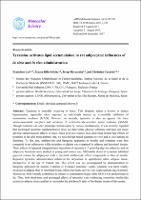Por favor, use este identificador para citar o enlazar este ítem:
https://repositorio.usj.es/handle/123456789/375
| Título : | Tyramine activates lipid accumulation in rat adipocytes |
| Autor: | Les Parellada, Francisco


Iffiú-Soltész, Zsuzsa 
Mercarder, Josep Carpene, Christian 

|
| Palabras clave : | Adipocytes; Monoamine oxidase; Semicarbazide-sensitive amine oxidase; Obesity; Glucose homeostasis; Vanadium; Glycerol |
| Fecha de publicación: | 2017 |
| Editorial : | AMER INST MATHEMATICAL SCIENCES-AIMS, PO BOX 2604, SPRINGFIELD, MO 65801-2604 USA |
| Citación : | Francisco Les, Zsuzsa Iffiú-Soltész, Josep Mercarder, Christian Carpéné. Tyramine activates lipid accumulation in rat adipocytes: influences of in vitro and in vivo administration. AIMS Molecular Science, 2017, 4(3): 339-351. doi: 10.3934/molsci.2017.3.339 |
| Resumen : | Tyramine is naturally occurring in foods. This biogenic amine is known to induce hypertension, especially when ingested by individuals treated by irreversible inhibitors of monoamine oxidases (MAO). However, in animals, tyramine is also an agonist for trace amine-associated receptors and substrate of semicarbazide-sensitive amine oxidases (SSAO). Though tyramine can alter aminergic transmission by various mechanisms, it was recently reported that prolonged tyramine supplementation does not deteriorate glucose tolerance and does not cause adverse cardiovascular effects in mice. Since previous studies have described insulin-like effects of tyramine in fat cells from diabetic rats, we have further tested tyramine in vitro and in vivo actions on fattening. To this aim, antilipolytic and lipogenic responses to insulin and tyramine were first compared in rat adipocytes while tyramine oxidation was compared in adipose and intestinal tissues. Then, effects of repeated intraperitoneal injections of tyramine (17 [tmol/kg/day) on adiposity and on adipocyte functions were studied in young and mature rats. Millimolar doses of tyramine inhibited glycerol release by adipocytes with a maximal antilipolytic effect comparable to that of insulin. Repeated tyramine administration enhanced fat deposition in epididymal white adipose tissue, irrespective of the age of treated rats. This effect was not accompanied by desensitization to lipogenic activation by insulin, tyramine or hydrogen peroxide. Lastly, tyramine was more readily oxidized in adipose than in intestinal tissues when enzymatic activity was expressed per mg of protein. Moreoever, MAO mostly contributed to oxidative deamination in gut while SSAO was predominant in fat. Thus, both short-term and prolonged effects of tyramine were evidencing somewhat insulin-like actions in adipose tissue and led to reconsider the risk/benefit ratio of the dietary intake of this amine. |
| URI : | https://repositorio.usj.es/handle/123456789/375 |
| ISSN : | 2372-0301 |
| Aparece en las colecciones: | Artículos de revistas |
Ficheros en este ítem:
| Fichero | Descripción | Tamaño | Formato | |
|---|---|---|---|---|
| molsci-04-00339.pdf | 792,65 kB | Adobe PDF |  Visualizar/Abrir |
Este ítem está sujeto a una licencia Creative Commons Licencia Creative Commons

